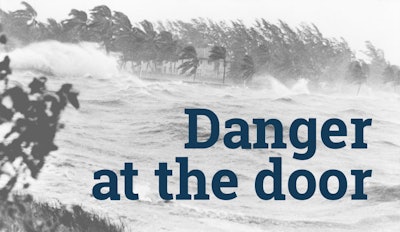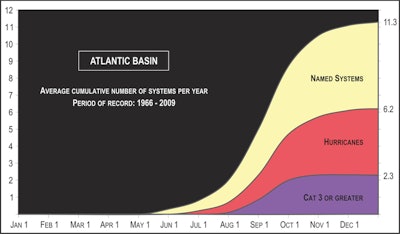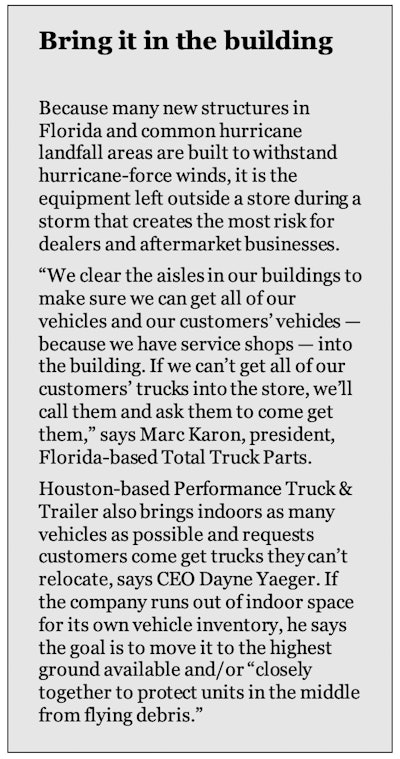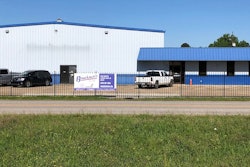
[This article was originally published in 2019 by Trucks, Parts, Service. It has been updated to include more timely information.]
As a hot summer rolls on, so arrives the beginning of hurricane season, one of the most dangerous periods of the year for a large population of Americans.
Though the National Oceanic and Atmospheric Administration (NOAA) defines hurricane season for the Atlantic Ocean as June 1 to November 30, most storms in the region that grow into hurricanes don’t begin forming until July and don’t reach the status of Category 3 storms or greater until early to mid-August. Tropical Storm Idalia, which is currently a category 3 storm and is expected to intensify into a hurricane before making landfall in Florida Wednesday, has been growing in strength for two weeks.
From 1966 to 2009, the NOAA reported the Atlantic basin averaged 11.3 named storm systems, 6.2 hurricanes and 2.3 Category 3 or greater storms per year.

For those living and working in areas that can be potentially impacted by hurricanes, it is imperative to have a disaster preparedness plan. Tropical storms and hurricanes move up to 100 miles a day and are capable of shifting direction and altering their size instantaneously.
A comprehensive hurricane preparedness plan can’t make those risks go away, but it can position a business and its employees to manage them as safely and carefully as possible.
Develop a task list and timeline
Unlike the tornadoes that ravage the Great Plains and Midwest and the earthquakes that occasionally shake California, hurricanes come with some advanced warning. Though some storms move faster, most hurricanes take at least a week from their initial discovery to reach the United States.
A good disaster preparedness plan should use that time wisely, noting specific points in the storm’s progression in which employees should be briefed, facilities should be protected and people should evacuate to safety.
“Our No. 1 priority is always the safety of our people. That’s the focus of our planning that everything else is built around,” says Marc Karon, president, Total Truck Parts.
With six locations across Florida, Total Truck Parts is no stranger to hurricanes. In 2019, Karon says the business prepared for days for Dorian, fearing the worse, only to be granted a fortunate reprieve when the storm turned northward after devastating the Bahamas. He says the planning followed a strategy the company has developed over a number of years that is deployed as soon as a new storm is identified.
At Total Truck Parts, Karon says the first thing he does when a new storm is discovered is bring his leadership team together for a call and brief them on the storm. Not every tropical storm observed in the Atlantic makes its way to Florida and even fewer grow large enough to impact each store, but Karon says it is still important that all of Total Truck Parts’ leadership team knows of the potential risk in case the storm tracks in their direction and grows.
It is a few days later, once a storm has developed into a major weather event, that the Total Truck Parts’ disaster plan kicks into high gear with a number of tasks that must be completed before the storm reaches the business. Karon says employees are notified as soon as possible (usually about three days ahead of a storm’s anticipated arrival) when the disaster plan needs to be engaged so preparations can begin.
Once it’s clear a storm is coming there’s a lot to do in little time so employees have to work fast, adds Don Purcell, partner, Stone Truck Parts.
“We start working as soon as we know [a storm is] moving our direction,” he says. “It might not always hit us but we have to be ready.”

Major tasks that should be included in any hurricane preparedness plan include moving inventory and equipment into safe places, securing facility doors and windows, powering down non-essential computers and electronics (or testing generators and alternative power sources), updating phone systems to notify customers of storm-related availability and acquiring and safely storing supplies that may be needed in the aftermath of the storm.
Karon mentions the phone systems as something his team learned the hard way during a recent storm.
“We had our phone system routing calls from a store that was closed to a store that was open, which was what we want to do,” he says. “But when we picked up as ‘Total Truck Parts’ we didn’t specify our location. The customer didn’t know he had reached another store.”
A facility’s ability to withstand hurricane winds and rain also should be taken into account when developing a pre-event checklist. Many structures in Florida are now built to withstand hurricane-level winds but their doors are not. Karon says Total Truck Parts uses pallets of brake drums and other heavy products to anchor their doors in position ahead of a storm to keep the interior of their business safe.
Flooding is an oft-overlooked killer as well. Not all areas devastated by hurricanes are destroyed due to excessive winds. Low-lying areas and regions where drainage is substandard require additional preparation ahead of a storm surge.
That’s how Hurricane Harvey caused so much damage in the Houston area in 2017.
Dayne Yaeger, CEO, Performance Truck & Trailer, says his company’s Houston store was closed for six days due to that hurricane, and operated while under construction for nearly a month after the storm had passed. Yaeger says Performance Truck & Trailer had a comprehensive facility preparedness checklist before the storm hit but the rain totals were so overwhelming that the business still had to deal with flooding.
Edward Neeley, president, Truck Supply Company of South Carolina, says he saw the same thing when Columbia, S.C., was hit by a hurricane’s storm surge earlier this decade. Neeley says thanks to a favorable location with high elevation his facility was able to escape the storm with minimal damage but customers and competitors in other corners of town weren’t so lucky.
“We had 49 inches of rain in 24 hours,” he says. “We didn’t even have a parking lot full of water, but down the street they had 16 feet of standing water.”
Yet despite his good fortune Neeley says Truck Supply still learned from the storm. He says the company takes great care to clean its gutters and storm drains ahead of every major storm and position fencing around both to ensure they remain unobstructed during a deluge.
“I don’t think everybody thinks about that,” Neeley says. “You need to remove as much debris as possible [before the storm] so that water has somewhere to go.”
Purcell adds moving any products that would be damaged if flooded to higher shelving is another preparation requirement.
Finally, Neeley says another thing he’s learned about hurricanes is they require an inventory of products above and beyond what a parts distributor or truck dealer normally has on hand. He says when a storm hits the Carolina coast, Truck Supply becomes a general supply company, providing customers positioned in and servicing the affected areas with dozens of random essentials, such as ice, gasoline and in some cases even cash.
“If there’s no power you can’t use a credit card,” he says. “We’ll run up to a bank and get them cash and send it to them, then just charge their account.”
Neeley’s comments hit on another important aspect of hurricane preparedness that cannot be overlooked — dealing with a storm doesn’t always end when the storm passes. Post-event expectations such as when employees should check in and how facilities should be entered, evaluated and re-opened also should be outlined in any comprehensive disaster strategy.
Communicate with employees
In addition to building checklists for what should be done within a business before and after a hurricane, those who have been through many say it is also necessary to have a simple plan for communicating with employees during and after a storm. Total Truck Parts uses a phone tree after storms to quickly make contact with all employees and determine all are safe and accounted for.
“That’s the first thing we want to know,” Karon says. “Is everyone okay? Does anyone need any help?”
[RELATED: Six unconventional items to acquire for internal use and distribution ahead of an impending storm]
When storms hit Florida directly Karon says the answer to the latter question will occasionally be yes, which puts the company in the position of helping an employee while also reopening the business. Fortunately, the business has prepared for that.
After Hurricane Irma damaged an employee’s home in 2017, Karon set up a hurricane assistance relief fund where aftermarket suppliers and distributors could donate funds or products that would be sold to help support the employee’s rebuilding efforts. Karon says the fund was instrumental in helping his employee get back on his feet and created a personal bond between the associate, business and industry that cannot be understated.
“He was so moved by that. He didn’t have to reach into his pocket for a dime,” he says.
Karon adds the fund is something he’d like to roll out on a larger scale in the coming years so everyone in the industry can pitch in to help each other during times of crisis.
Yaeger did something similar after Harvey, setting up a fund with the Disaster Relief Foundation. Eventually supported by Kenworth Truck Company and its nationwide dealer network, Performance Truck & Trailer was able to raise more than $230,000 for its associates.
“We started to get feedback from a lot of our people that they did not have flood insurance because they weren’t in areas that required it,” Yaeger said at the time. “We knew we wouldn’t be able to take care of everything but we wanted to be able to take care of something [for our employees].”
Employers can aid their associates in other ways as well. Old River Volvo President Lee White says he once rented hotel rooms ahead of a looming storm so employees would have a place to stay in case their homes were damaged. When a few employees unfortunately needed the housing later, White says he was glad he’d thought ahead.
“To this day when I go to that store I have employees come up and thank me. ‘We wouldn’t be here if you hadn’t done that. We wouldn’t have had a place to live,’” he says.
Employers also must have clear messaging to inform employees on the status of their business throughout a storm event. Purcell says Stone Truck Parts has had success with a corporate hotline and customized messages created for each weather event. Yaeger says Performance Truck & Trailer used Facebook to communicate with customers and employees during Harvey. Others use a combination of phone calls, emails and intranet sites.
At Tidewater Fleet Supply, managers at the company’s branches that expected to be impacted by a storm email associates three days before the storm’s arrival to communicate expectations and safety procedures.
Due to unique supplier contracts with the cities of Chesapeake and Hampton, Va. — the company provides onsite parts management for both municipal fleets — Tidewater Fleet Supply never totally closes down during a storm. Former President Allan Parrott, who retired earlier this year, said in 2019 Tidewater employees are required to staff city facilities and the company’s warehouse during an emergency event, so he said those employees need to know as soon as possible what they will need to do and how to stay safe.
He said the company’s other locations that do close follow a similar protocol, with branch managers leading storm preparations, withdrawals and reopening the store’s once an all-clear is received. In each instance, Parrott said Tidewater Fleet Supply relies heavily on local governments to determine when it’s time to leave, and return, to a store.
“For Dorian, we closed our Jacksonville, Fla., store for two days and Savannah, Ga., for three days,” he says.
The story was similar in south Florida, where Karon says Total Truck Parts’ stores reopened quickly after the storm.
But that’s not always the case.
Says White, “There’s no one-shoe-fits-all strategy because you never know exactly what to expect.” On that note, Old River Volvo has been fortunate; since expanding its presence in Louisiana earlier this decade the dealership has not yet been seriously impacted by a hurricane. Yet White says contingency plans have been developed in the event of future severe weather.
“The possibility of all four of those stores getting hit by the same storm is not very high, but it is conceivable that one or two could be hit hard and we would have to serve those customers from another store,” he says. “We hope it doesn’t happen, but we still have to discuss the possibility.”
Communication is vital when a facility has suffered major damage as well. Just because a store can’t open doesn’t mean employees won’t be needed on site to assist with clean up. Store managers and department leaders may be tasked with communicating with municipalities, local disaster relief teams and the Federal Emergency Management Association. Other associates will be needed to check inventory and begin the physical work of cleaning up the mess.
Neeley says Truck Supply is far enough inland that it rarely suffers a direct hit from a hurricane. But even with that advantage, he says the company still waits to confirm its employees are safe and available before calling them back to work. He says most employees are eager to get back to work and return to a sense of normalcy if they can.
“It’s not a normal situation but also people don’t want to dwell on it,” he says. “They want to get past it.”
Dealing with the aftermath
The final steps of a hurricane preparedness plan are the ones most business owners never hope to use — what to do when a business is damaged.
At Total Truck Parts, Karon says he’s the first person to return to his West Palm Beach store and requests his store managers do the same at their locations. He says the first step on arrival is a safe, simple survey of the building. Does there appear to be any significant damage? Are doors or windows destroyed? Has there been flooding and, if so, how bad is it? Karon says answering these questions helps the business determine what to do next.
“You want to know as soon as possible what you’re up against,” says Purcell.
And though it may seem logical, Karon notes contacting one’s insurance provider isn’t always the next step. The damage has to justify the call.
“Hurricane insurance is very expensive and it has very high deductibles,” he says. “I would have to have a $450,000 loss before they would kick in $1.”
It’s also in these early stages when business leaders have to determine if/when a damaged facility can reopen, and how customers will be served. Shifting business from a damaged store to an unimpacted location in another town is a logical next step, but it’s not available to everyone. Small businesses or companies with locations separated by hundreds of miles may not be able to easily service customers in the affected area from another store. In these instances, business owners need to determine if it is better to attempt to serve a customer from another region, partner with an unaffected regional competitor to provide short-term customer assistance or wait until a damaged facility can reopen to return to the market.
“I don’t want to open a branch back up until I feel reasonably confident that we can bring back at least 75 to 80 percent of our employees,” says Purcell. “I would rather route customers to another branch to serve them rather than opening and providing poor service because we don’t have the people.”
Another decision that must be made is how much support can realistically be provided. One-hour delivery isn’t always feasible after a hurricane. Sometimes no deliveries can be made. Those who live in areas afflicted by hurricanes say they will occasionally request customers come to their stores to pick up parts immediately after the storm to avoid sending their delivery drivers into peril.
Parrott said Tidewater Fleet Supply outside sales associates are all provided keys to their stores so they can meet customers and provide parts in instances where a store is closed or delivery is not available.
“We try to make sure if they can get to us we can get them the part they need,” he said.
For what it’s worth, those same experts say most customers are understanding. After all, they are likely going through the same issues in their business. Neeley says that’s why Truck Supply works so hard to stock or acquire the unconventional products customers need after a storm. He says going above and beyond during a stressful period can go a long way toward strengthening customer loyalty.
“In those situations, everyone is dealing with the same thing, so [customers] just want someone they can rely on,” he says. “If you can get them what they need they don’t care what it costs. Just don’t gouge them. They know you need to make money.”
White has heard the same thing from his customers after a storm.
“Most are pretty appreciative that we’re even open and can help them,” he says. “It’s a stressful time but everyone works through it.”










